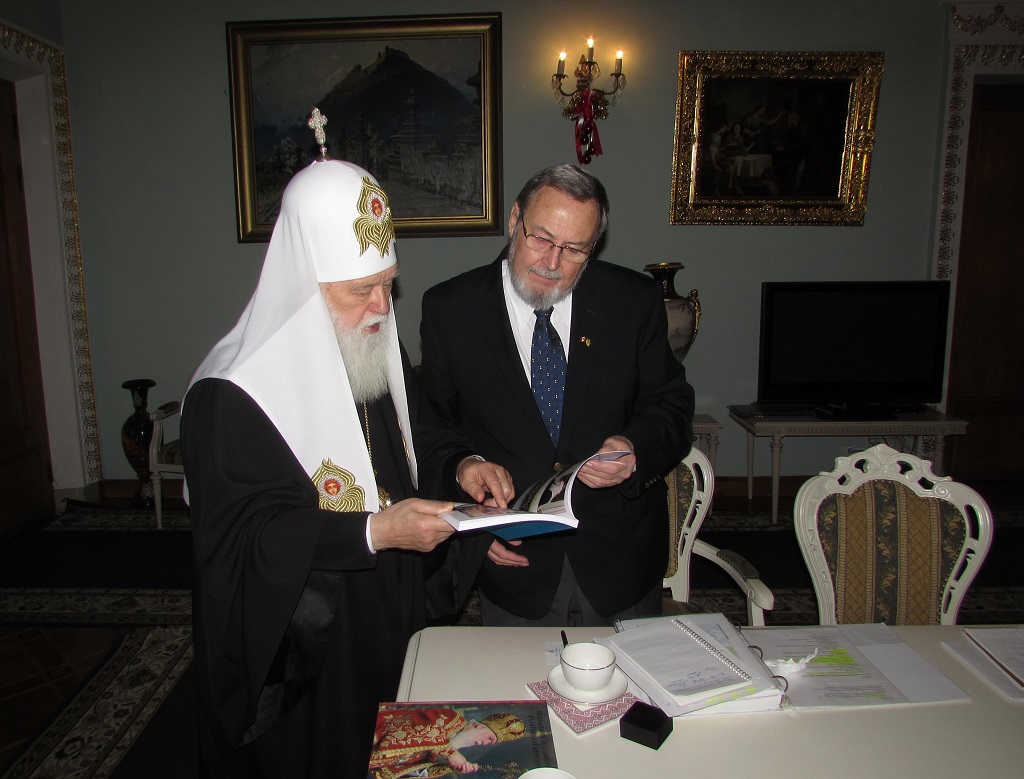Peter Goldring for New Pathway, Edmonton.
The significance of the recent message from the press centre of the Kyiv’s Patriarchate of the Ukrainian Orthodox Church Patriarch Filaret is of great importance to Ukraine.
During the conduction of my determination of the importance to Ukraine of a unified Kyiv based recognized Orthodoxy, I met with Patriarch Filaret for some two hours. He was very encouraging of my dialogue with all parties concerned. Over the course of some 100 meetings, 45 days in Ukraine alone, I summarized the importance of Orthodox unity and recognition for Kyiv Ukraine by the Ecumenical Patriarch Bartholomew of Constantinople, Turkey.
It is well worth reiterating the historical truism of Eastern European Orthodox foundation in Kyiv to fully understand the great importance for Kyiv Ukraine to once again be fully recognized as the principal birthplace of Orthodoxy in Eastern Europe.
Today, Ukrainian national identity hinges on history, culture, and religion, all of which are linked to the Orthodox faith. When Ukraine’s modern boundaries were drawn in 1991, at the end of the Soviet Union (USSR), establishing national consciousness was difficult in the multi-ethnic state. Indeed, Ukraine’s two major ethno-linguistic groups are Ukrainian and Russian. However, most recently, these groups have been divided religiously. In fact, this religious schism is more political than it is spiritual, and can be found between the Ukrainian Orthodox Church of the Kyivan Patriarchate (UOC KP), the Ukrainian Autocephalous Orthodox Church (UAOC), and the Ukrainian Orthodox Church of the Moscow Patriarchate (UOC MP).Ukraine’s national consciousness has its foundations in 988 with the introduction of Orthodoxy into Eastern Europe by Prince Vladimir of Kyiv. Here, Orthodoxy became a cultural and religious force in the region. While the UOC KP and the UAOC have been moving towards a national ‘Ukrainian’ church, the Moscow Patriarchate has been working, albeit under the influence of Russian President Vladimir Putin and the Russian Orthodox Church of the Moscow Patriarchate (ROC MP), to strengthen the Kremlin’s influence in Ukraine and align its political circles closer to Moscow. Politicians and religious leaders recognize this problem. While rifts in Ukraine’s population are not an exclusive result of religious divide, they delve into a greater debate concerning Ukraine’s identity and historic links to Russia. I cannot emphasize enough that Ukraine is the home of modern Slavic culture and the birthplace of Orthodoxy in Eastern Europe, not Russia.
Historically, between 882 and 1240, Ukraine was known as Kyivan-Rus’ and spanned the area historically known as Rus’, which, by the eleventh century, was the largest state in Europe. It included the northern part of Ukraine, the northwestern Russia, Belarus, and some parts of Finland, Poland, and Slovakia. From the tenth century to the thirteen century, Kyiv was the capital of the first Slavic empire, Kyivan-Rus’.
It was in 998, at the ancient city of Korsun, that Prince Vladimir of Kyiv was baptized into the Orthodox faith by Patriarch Basil of Constantinople, ushering in a new era for the region. Vladimir rejected paganism in favour of Orthodoxy from Byzantium, the most powerful city and trading partner in the region. According to Ukrainian folk legend, Vladimir chose Orthodoxy because it meant that the Church was under the state, not equal to the state (Islam) or above the state. And, by forcing his people to convert by way of a state religion, Vladimir raised the international prestige of Kyivan-Rus’ and consolidated his rule over his subjects. Overall, this event signaled the beginning of ethnic similarity, a common language, common material culture, common territory, and a nascent common economy and government. It was, arguably, the beginning of Slavic organization.
In 1051, the first monastery, the Monastery of the Caves, was established in Kyiv by St. Anthony, who has since been officially recognized as the founder of monastic traditions in all Kyivan-Rus’. Historically, all but two Metropolitans who followed were Greek – Hilarion in 1051 and Clement in 1147 – both of whom were Kyivan. To this day, the Orthodox Church in Ukraine still sings in Greek when Bishops are welcomed because of the debt owed by the Orthodox Church to Greek Byzantium. Both the religious and cultural impact that Kyivan-Rus’ Orthodox conversion and missionary work – locally and across the region – was profound.
With the Mongol invasion of 1237, unrest plagued Kyiv until 1480, and, during this period, only the Church is credited with keeping national consciousness in Kyvian-Rus’ alive. In the wake of occupation, the primary See of the Orthodox Church was temporarily moved from Kyiv to Muscovy, by then a small principality on the outer regions of Kyivan-Rus’, by St. Peter, Metropolitan of Kyiv. At the time, the Duchy of Muscovy was no larger than 3,000 sq.km. Missionaries and monks soon spread throughout Eurasia as Rusyn influence expanded.
In 1440, Constantinople accepted union with the Roman Catholic Church, a prospect that the Orthodox Church, now in Muscovy, could not accept. Finally, in 1448, a council of Muscovite Bishops elected their own Metropolitan. Muscovy began to be seen as a Third Rome, and the Grand Duke of Muscovy assumed the titles of ‘Byzantine Emperors Autocrat’ and ‘Tsar’ – a term meaning ‘Caesar’ that was used to designate Slavic monarchs as supreme rulers – the earthly protector of Orthodoxy. By 1530, the Rusyn influence in Muscovy the area soon designated ‘Russia’ – translating to the ‘people of Rus’ – despite not having control over Kyiv, the majority of Kyivan-Rus’ lands, and, by association, the traditional Rusyn areas around the Black Sea.
In 1589, the head of the Church in Moscow, was elevated to the rank of Patriarch by a Synod of Bishops. However, in the traditional area of Kyivan- Rus’, Kyiv was under the control of the Polish-Lithuanian Commonwealth and not under the jurisdiction of the Tsarist Muscovy. While Muscovy was thought to be the seat of Orthodoxy in Eastern Europe, Slavic-Orthodoxy did not originate there, rather deriving its historical beginnings from Kyivan-Rus’ (Ukraine today). Even while the Ecumenical Patriarch presided over all Orthodoxy vis-à-vis Constantinople, Russian Orthodoxy was declaring itself as the first among equals, the title reserved exclusively for the Ecumenical Patriarch. For Kyiv, this meant that Moscow’s declaration of authority placed itself higher than Churches in other lands, like Kyiv, despite none of the territory around Kyiv, or any Ukrainian lands, being under Moscow’s control.
In 1686, despite opposition in Kyiv, Tsarist Russia successfully subordinated the Ukrainian Orthodox Church to the Patriarch of Moscow. The autonomy of the Ukrainian Orthodox Church was violated, and 250 years of Russification and the destruction and uprooting of all signs of independence of the Ukrainian Church followed. Today, it is claimed, Ukraine and Russia should remain distinct from each other. Ukraine certainly wishes for this, but Russia’s power and sense of entitlement to the historic Orthodox-Christian lands have incited a great deal of conflict amid a Russian drive for influence and authority inside Ukraine’s borders.
It is important to note the origins of Rus’ as they pertain to Kyivan-Rus’, thus establishing the Ukrainian character of the historic state. Some historians, popularly known as ‘Normanists’ agree that Kyivan-Rus’ was established by Scandinavians who conquered the tribal areas and established Kyivan-Rus’ as a monarchy in the ninth century. They draw on the last revision of the Primary Chronicle of 1118, as well as linguistic data, to substantiate their case.
This influence might be overstated, however. Rus’ was established much earlier than the arrival of the Scandavanians. Because the lands of Kyivan- Rus’ are found along the Dnieper River, which indirectly links the Baltic and Black Seas, a multi-ethnic demographic was unavoidable. The name Rus’ was applied to the territory ruled by Kyiv, though it was originally associated with the Dnieper region, just around the city. The area was home to a Slavic tribe known as the Ros. From here, the Ros are said to have united the Slavic peoples into a new tribal union known as Rus’. After the tribes were unified and Rus’ was established, further expansion was understandable.
It was the expansion of Rus’ northwards from Kyiv, and the state’s increasing control over the area’s Slavic tribes, that formed the backbone for Kyivan- Rus’ in the ninth and tenth centuries. With the center at Kyiv and the breadth of the state’s lands, found around the Black Sea and ruled by Kyiv, legitimize the notion that Ukraine is not Russian, but that Russian culture was an expansion of Kyivan-Rus’ later on. In fact, the foundation for what is today Moscow was only laid in 1147 when Grand Prince Yuri of Kyiv, the founder of Muscovy, first made mention of the small trading post.
While Ukraine held particular importance within the general narrative, it was not always included. And, for a time, portions of Kyivan-Rus’ history were forgotten, such as the centrality of Kyiv to Slavic civilization. However, when Kyiv and the surrounding areas were incorporated into the Russian Empire in the seventeenth century, the role of Kyivan-Rus’ was further emphasized. Only in 1674, after Kyiv was annexed, was the city identified as the first capital of the Russian state, and Russia and Ukraine were recognized as one ‘Slavic-Russian’ people. Cultural differences between the two suggest otherwise.
Today, Ukrainian identity revolves around the 988 and Orthodox-Christianity. Recognizing Ukraine’s past and the importance of the conversion of Kyivan-Rus’, the Ecumenical Patriarch Bartholomew, leader of the Orthodoxy world- wide from Constantinople, Turkey, has acknowledged the centrality of the event, as well as Kyiv, to the unity of the Ukrainian people and the spirituality of Eastern Europe. Certainly, Ukrainians have turned to the cultural sphere to locate an identity that has long been characterized by Orthodoxy and the legacy of Kyivan-Rus’ – the cradle of Slavic culture. Today, we can all agree, Ukraine remains distinct and holds a special place in European history as the birthplace of Orthodoxy in Eastern Europe.
In my many visits in Ukraine with religious leaders, there is a common recognition of not only Orthodox but Ukraine’s Catholic, Jewish, Protestant, Islamic leaders, all but Moscow Patriarchate, that Ukraine’s future is best served by the recognition of Constantinople Ecumenical Patriarch Bartholomew of Autocephaly status for Kyiv Patriarchate as the birthplace of Orthodoxy in Eastern Europe.
Share on Social Media


































